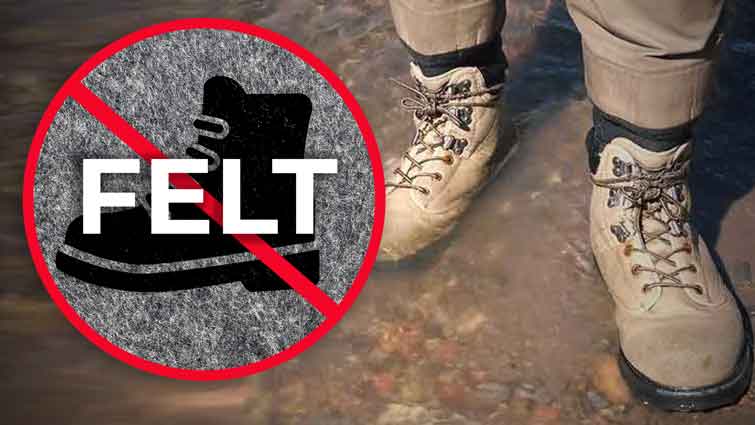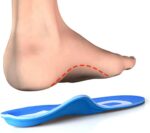Traditionally, anglers used, (and many still do), felt wading boots for the great grip they offer on slippery surfaces. The felt material will swell in the water and offer exceptional traction whether moving on gravel or sand.
The year 2008, the problem of invasive species burst onto the scene and raised ecological awareness.
With this awareness, the wading boot that featured a rubber sole gained popularity, particularly among a new generation of anglers.
But felt wading boots still command a following among more traditional fishermen.
So, which kind of wader best meets your needs, and why?

Felt or Rubber Wading Boots?
The principal difference between these two types of wading boots can be found in the traction that they offer.
If you are a stream fisherman and often must navigate slimy and slippery surfaces of rocks covered in algae or moss, felt might be your choice.
If, however, you must walk over rough terrain to arrive at your favorite fishing spot or move in an environment with sharp rocks and lots of mud, rubber waders may prove to be a more pragmatic choice for you.
Rubber waders are also perhaps the only viable selection for winter fishing as felt waders offer absolutely no traction in the snow.
Both kinds of waders can have studs installed for increased traction so that any lack of grip can be compensated and improved upon.
Selecting a Felt Wader: What Are Felt Waders?
Felt wading boots are characterized by a felt sole. These soles are made of a thick, heavy piece of felt fabric, that is then attached to the bottom of the wading boot.
When felt makes contact with the felt surface, the felt fabric molds to whatever the shape is of the surface and provides superb traction thanks to the material’s roughness and swelling when submerged in water.
What’s Good About Felt Waders?
The principal reason that felt waders are still incredibly popular among anglers is the traction that the felt sole offer. Felt is extremely effective for gravel surfaces and sandy surfaces.
When fly fishing in streams and rivers where moss and algae typically cover stone or wood surfaces both underwater and above water, felt offers an excellent solution.
Felt waders provide more friction because they have a rougher texture and if you install studs, the grip increases notably.
Are Felt Waders Banned? Where and Why Are They Banned?
In some states, yes indeed felt waders are banned. Why? Research has determined that the fibers used in felt material can harbor species for considerable periods.

These species are invasive and damage ecosystems. Hence, this type of wader sole has been connected with the transfer of invasive species from one body of water to another and is capable of negatively influencing the variable and delicate ecosystems in streams and rivers anywhere.
As of 2021, these U. S. States Banned the use of Felt Waders:
-
-
- Alaska (banned felt waders in 2012)
- Maryland (banned felt waders in 2011)
- Missouri (banned felt waders in 2012)
- Nebraska (banned felt waders in 2013)
- Rhode Island (banned felt waders in 2012)
- South Dakota (banned felt waders in 2013)
-
Felt waders were also banned in Yellowstone National Park in 2018.
At the writing of this article, other U. S. states that are considering the banning of felt waders include:
-
-
- Oregon
- New Mexico
- Montana
- Maine
- Idaho
-
Some parasites have the ability to latch onto the felt material used as outer soles. These harmful species will then travel to a new body of water that is not their natural habitat and where they would never arrive.
Invasive parasites especially in the form of bacteria will attach to the felt and then spread to other rivers, streams, and lakes.
They can attack aquatic life within the water bodies and harm the ecosystem’s balance by proliferating in a completely new location.
One aspect that facilitates and encourages this passage from one water body to another, is a precise characteristic: these soles are not quick-drying, so organisms can survive longer even when attached to the felt.
Contrasting the Risks of Parasitic Transfer with Felt Waders
If you live in a state where felt waders are not yet banned, and you prefer them to rubber waders due to local surface necessities, you still can do your part to protect the environment and future angling.
Keeping your boots clean will make them safer for the stream, river, or lake you fish in. When you have finished your angling for the day, remove mud or dirt using a small brush such as a toothbrush.
Prepare to soak felt outer soles with one cup of a boot cleaning solution of detergent in a gallon of water. Soak the felt bottoms of your waders in this solution for a minimum of half-hour.
Remove the wader bottoms and rinse thoroughly. Allow your waders to dry completely. When using a detergent, select one that is lethal to invasive species such as didymo.
Selecting a Rubber Wader: Are They Superior to Felt Waders?
Approximately fourteen years ago, the spread of invasive species through the use of felt waders in angle fishing came to the forefront in the ecological battle to protect bodies of water and their ecosystems.
Footwear manufacturers also began producing waders that specifically used rubber outer soles. Thanks to advances in materials and designs, rubber waders are a competitive alternative to traditional felt waders.
What Are Rubber Waders?
Rubber waders feature soles produced in rubber with tread designed specifically for grip and traction. They are generally abrasion-resistant which is important if must walk long distances to arrive at your favorite fishing spot.
So, how are rubber waders a viable alternative to traditional felt waders?
1.) Ecologically Risk-Free
Rubber will not harbor invasive species, making It the ideal choice for the ecologically minded. Parasites and invasive species cannot attach to a rubber surface, eliminating the risk of spreading them from one water body to another.
2.) Equal Traction and Grip Capabilities
Once upon a time rubber outer soles could not compete with felt wader bottoms. But technological advancement and innovative materials have leveled the competition, and rubber waders in some cases may even be superior. Plus, studs can also be added to rubber waders as well.
3.) Quicker Drying
Rubber dries very quickly and will not retain moisture. This is a crucial quality because it is unlikely that invasive and parasitic species can survive without moisture retention, without water, life does not survive.
Rubber boots are also easier to dry if you plan on visiting two different fishing locations within a short period.
4.) Snow Capable
Felt waders are not adapted to snowy conditions. They freeze making traction impossible. Rubber repels moisture and is easy to dry manually.
Are rubber waders good for winter fishing? Rubber waders are the preferred wader in winter. The rubber outer sole will perform exceptionally well when surfaces are snow-covered.
Because rubber is naturally water-resistant and repellent, there is no risk of snow or ice crystals sticking on soles to impede efficacious traction.
5.) A Sustainable Choice
Rubber waders last much longer than felt waders. Felt waders wear out quickly and must be replaced or re-soled. Rubber waders, no. Rubber weathers wear and tear batter and longer. If you acquire a very high-quality pair, they may last a lifetime.
See also: No More Fear to Use Felt Hats in Rain
In Conclusion
If you live in an area where felt waders are banned, your choice has already been made for you. If you are still undecided, felt waders inevitably offer a spectacular grip, especially on slippery moss and algae-covered surfaces.
But, as most anglers respect nature and ecological considerations, and if you don’t want the hassle of disinfecting and cleaning your felt waders after every use, rubber waders offer the security of not transporting invasive species to new bodies of water.
If you like the advantages of both, consider a wader with interchangeable soles, so you get the best of both in a single wader boot such as the Darkhorse model from footwear manufacturer Korkers.







